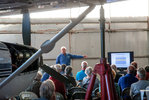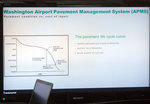An airport engineer with the Federal Aviation Administration (FAA) voiced his support for rehabilitating the Jefferson County International Airport runway in 2019 as planned, rather than waiting …
This item is available in full to subscribers.
We have recently launched a new and improved website. To continue reading, you will need to either log into your subscriber account, or purchase a new subscription.
If you had an active account on our previous website, then you have an account here. Simply reset your password to regain access to your account.
If you did not have an account on our previous website, but are a current print subscriber, click here to set up your website account.
Otherwise, click here to view your options for subscribing.
* Having trouble? Call our circulation department at 360-385-2900, or email our support.
Please log in to continue |
|


An airport engineer with the Federal Aviation Administration (FAA) voiced his support for rehabilitating the Jefferson County International Airport runway in 2019 as planned, rather than waiting longer and eking a few more years of life out of it, as some pilots have urged.
In June, Gary Lanthrum, president of the Jefferson County Pilots Association, questioned the rehabilitation plans and noted that the 3,000-foot runway scored a fairly high 77 out of 100 on a visual inspection method called a pavement condition index (PCI), used to evaluate runway condition. Lanthrum argued that the area’s mild weather means the county airport’s runway hasn’t aged as rapidly as other runways in the state, and he asked that rehabilitation be delayed until it was truly needed.
Built in 1990, the runway was designed to last 20 years. If the rehabilitation goes as planned, the runway will have lasted nine years longer than is typical.
FAA engineer Kevin Latschaw said the PCI is “just one tool of many that we use to decide which airports would get funding in a given year.
“There’s definitely an optimal point on the PCI curve to fund a runway – that ‘lowest life-cycle cost’ point at which you can extend the life of the pavement for the cheapest overall [cost],” Latschaw said during an Oct. 5 airport workshop meeting.
“And we are trying to hit that to the best of our ability. Believe me. We’re all taxpayers as well,” Latschaw said.
LIMITED FUNDING
Funding for state airports is limited, and there are more than 100 airports that would snap up the dollars if those funds are not allocated to Jefferson County’s airport, Latschaw said.
“We’re very comfortable at FAA with funding the project now. And that’s why the project is slotted. If a project does slip from its planned schedule, that money is not automatically available next year,” Latschaw said.
“As I alluded to before, we’re in a seven-state region and … there is potentially hundreds of other airports that will take that money and use it for a project at their airport. And we don’t know when the next time it will be available to come back around to Port Townsend,” he added.
Because the county airport is not a major facility, it can’t just be added to the runway repair list whenever desired.
Latschaw said it is impossible to fund and time every project perfectly, and added that it is more cost effective to repair a runway earlier than to wait too long.
He also said it is unlikely the county airport’s PCI score would increase during the next inspection.
$265,809 FOR PHASE ONE
The FAA would fund 90 percent ($239,229) of the $265,809 cost of phase-one design through its Airport Improvement Program. The remaining 10 percent ($26,580) is to be funded by a combination of Port of Port Townsend matching funds – the port operates and maintains the airport – and a Washington State Department of Transportation (WSDOT) grant.
Eric L. Johnson, construction and grants program manager with WSDOT, said the pavement life-cycle curve “shows the typical life cycle of the pavement and illustrates that at about 75 percent of the pavement’s life, the degradation gets more intense.”
Thus, it is cheaper to fix a runway before that 75 percent mark, Johnson said.
State runways are evaluated every five years through WSDOT’s Washington Airport Pavement Management System, he said.
Lanthrum and other pilots were concerned that a rehabilitation project could close the airport for too long during construction.
Eric Toews, director of planning for the port, said the port would do what it could to mitigate impacts of construction.
AVIATION GROUP IN FAVOR
Warren Hendrickson, manager for the Northwest Mountain Region of the Aircraft Owners and Pilots Association, said the rehabilitation plan is a good idea.
“I have the advantage of seeing 600-plus airports across seven states … we are very blessed here at Jefferson County for the circumstances we have: a combination of good weather and good maintenance by the port. We’ve already had a runway that has exceeded its lifetime expectations,” Hendrickson said.
Hendrickson said he has been to other airports and Jefferson County’s facility “is a ‘good news’ story here, I have to tell you. I see some real nightmares,” he said of other, mismanaged airports.
Washington’s airports require $8.4 million every year just to keep them in their current condition, Hendrickson said, and money is tight as the state Legislature is dealing with other things, such as school funding and roads.
However, he said, “We don’t need new taxes or fees to go and generate those [airport] funds. All we have to do is take the money that we’re already paying on airports through our leasehold excise tax through the sales taxes on the airports and rededicate that from the general fund back into the aeronautics accounts.”
The five-year airport planning cycle meshed with regional and national schedules for airports, creating a complex “Rubik’s Cube” of scheduling, for which getting perfect timing to repair a runway at exactly the right time is not possible, he said.
Jefferson County International Airport should renovate its runway now, Hendrickson said, because “sometimes the PCI – in this particular case – is probably a little bit better than what we might have anticipated, but the funding is available. And the funding may not be available a year or two years down the road.”
“If you wait until [the PCI curve] does drop off the cliff, it does get expensive, and then you’re in an emergency repair basis, and nobody wants to be there,” Hendrickson said.
One person at the meeting questioned the cost of hiring runway consulting firms and also asked why a local road crew couldn’t just pave the runway.
“Consultants are absolutely key,” Hendrickson replied.
“The expertise that federal and state standards require in terms of pavement, management and engineering standards, and the requirements that the FAA levels on our airports in terms of markings and consistency and standards, is so unique that a road department or a regular engineering or civil engineering firm does not have the expertise. [Consultants] are specialty firms in aviation engineering – that this is all that they do.”
Hendrickson thanked the attending Jefferson County pilots for their interest.
“The fact that we’re having this conversation 18 months before the project takes off – this is huge. No airport does this, honestly. At all the airports I work with across seven states, this is unusual. And it’s great. It’s great because it gets the dialogue started.
“We’re going to have a primo airport and a primo runway. It’s going to be fabulous.”